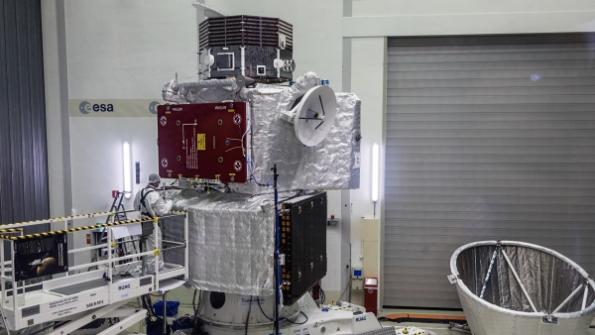
LYON, France–The European Space Agency (ESA)’s BepiColombo, the probe it launched in 2018 to study the planet Mercury, is performing a flyby of Earth this week as a gravity-assist maneuver in its seven-year-long journey.
It will be as close as 12,700 km to Earth on April 10 at 6:25 am CET. Communications have been almost continuous since April 7 and will last until April 13, says Elsa Montagnon, the mission’s spacecraft operations manager. Command uploading was completed last week.
The flyby will slow BepiColombo by 4 km/sec.—such slowing down is required for spacecraft traveling toward the Sun, due to its attraction. “This is very effective. The electrical propulsion system is only capable of a 2.8 km/sec. speed reduction over the entire mission,” Montagnon said. In total, nine gravity assists will be performed over the course of the voyage.
When close to Earth, a challenge will be the 34-min. eclipse in the planet’s shade. The Mercury transfer module’s (MTM) battery has been preheated, 24 hr. before the flyby, to ensure it performs at its best.
Several scientific instruments will be tested during the flyby. The Phebus spectrometer will be calibrated using the Moon as a well-known object. Phebus was designed to study Mercury’s exosphere, which could have been blown away by solar wind but seems to be renewed constantly.
Phebus is aboard ESA’s Mercury Planetary Orbiter. The MTM, an ESA design as well, also carries the Mercury Magnetospheric Orbiter (Mio). The latter was designed by the Japan Aerospace Exploration Agency (JAXA).
ESA and JAXA are partners in the mission. The Mio will study Mercury’s magnetic field. Given the planet’s size and what is known about its core, scientists are wondering why such a field exists.
The flyby maneuver will be performed at ESA’s European Space Operations Center (ESOC) in Darmstadt, Germany, which has been impacted by the COVID-19 pandemic. Most of its employees are working from home. Those on site have to comply with strict health protection measures.
For the flyby, Montagnon has managed to keep changes to a minimum. Eight engineers (including her) are working in three 12-hr. shifts. They are being helped by a ground station expert, as ESOC is resorting to three stations in Argentina, Australia and Spain. Another 10 staff members are on site, in charge of ESOC’s infrastructure.
All have to comply with social distancing rules. In the control room, engineers may not leave their seats and take a look at their neighbor’s display, Montagnon said. At the least, the control room’s configuration leaves enough distance between seats.
This is the last time BepiColombo gets any closer to Earth. Its next flyby is scheduled for October near Venus. Injection into the orbit of Mercury—the Solar System’s innermost planet—is planned for 2025.





